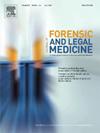南非计算机断层扫描样本中股骨远端性别二态性
IF 1.2
4区 医学
Q3 MEDICINE, LEGAL
引用次数: 0
摘要
股骨远端提供了可靠的性别估计标记。然而,在南非的背景下,评估股骨远端性别二态性的标准只包括对骨骼遗骸的有限测量。为了提高标准的适用性和可靠性,即使遗骸是碎片,该研究旨在从当代3D计算机断层扫描(CT)模型中收集一组扩展的地标,以研究股骨远端性别二态性。将19个地标放置在年龄在18-80岁的南非黑人(50男50女)远端股骨CT扫描的3D模型上,从中计算15个线性测量值,并使用重复性测试、学生t检验、Mann-Whitney检验、判别函数分析(DFA)和几何形态计量学进行分析。测量结果是可重复的,并证明了显著的两性二态性,男性通常表现出更大的尺寸。远端上髁宽度(DEB)的分类准确率最高,黑人为81%,白人为95%。判别函数方程在每个种群组中分别提高了2%的分类精度。与线性维度相比,基于形状变化的分类准确率在黑人中所占比例相似,但在白人中所占比例较低。一组扩展的、准确的、可重复的股骨远端测量结果被用于单独的截止值或作为性别估计的判别函数方程的一部分。DEB尤其有价值。形状变化并没有造成实质性的差异,对残片残骸也没有用处。观察到的人口差异强调了在法医人类学中制定针对人口的标准的重要性。本文章由计算机程序翻译,如有差异,请以英文原文为准。
Sexual dimorphism of the distal femur in a South African computer tomography sample
The distal femur offers reliable sex estimation markers. However, in the South African context standards for assessing sexual dimorphism from the distal femur has only incorporated limited measurements on skeletal remains. To enhance the applicability and reliability of standards, even if remains are fragmentary, the study aimed to collect an expanded set of landmarks from contemporary 3D computed tomography (CT) models to study sexual dimorphism in the distal femur.
Nineteen landmarks were placed on 3D models of the CT scans of distal femurs belonging to Black South Africans (50 males and 50 females), aged 18–80 years, from which 15 linear measurements were calculated and analyzed using repeatability tests, student's t-test, Mann-Whitney test, discriminant function analysis (DFA), and geometric morphometrics.
The measurements were repeatable and demonstrated significant sexual dimorphism, with males generally exhibiting larger dimensions. The distal epicondylar breadth (DEB) achieved the highest classification accuracies of 81 % in Blacks and 95 % in Whites. Discriminant function equations improved classification accuracies by 2 % in each population group respectively. Compared to linear dimensions, classification accuracies based on shape variation delivered similar percentages in Blacks but lower percentages in Whites.
An expanded, accurate, and repeatable set of distal femoral measurements was produced to be applied as individual cut-off values or as part of discriminant function equations for sex estimation. The DEB was particularly valuable. Shape variation did not make a substantial difference and is not useful for fragmentary remains. The population variation observed underscores the importance of developing population-specific standards in forensic anthropology.
求助全文
通过发布文献求助,成功后即可免费获取论文全文。
去求助
来源期刊

Journal of forensic and legal medicine
MEDICINE, LEGAL-
CiteScore
2.70
自引率
6.70%
发文量
106
审稿时长
57 days
期刊介绍:
The Journal of Forensic and Legal Medicine publishes topical articles on aspects of forensic and legal medicine. Specifically the Journal supports research that explores the medical principles of care and forensic assessment of individuals, whether adult or child, in contact with the judicial system. It is a fully peer-review hybrid journal with a broad international perspective.
The Journal accepts submissions of original research, review articles, and pertinent case studies, editorials, and commentaries in relevant areas of Forensic and Legal Medicine, Context of Practice, and Education and Training.
The Journal adheres to strict publication ethical guidelines, and actively supports a culture of inclusive and representative publication.
 求助内容:
求助内容: 应助结果提醒方式:
应助结果提醒方式:


